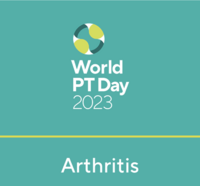World PT Day
About World PT Day[edit | edit source]
World PT Day is on 8th September every year. The day is an opportunity for physiotherapists from all over the world to raise awareness about the crucial contribution the profession makes to keeping people well, mobile and independent.
In 1996, the World Confederation of Physical Therapy (WCPT) now known as World Physiotherapy designated 8th September as World PT Day. This is the date World Physiotherapy was founded in 1951.
The day marks the unity and solidarity of the global physiotherapy community. It is an opportunity to recognise the work that physiotherapists do for their patients and community. Using World PT Day as a focus, World Physiotherapy aims to support member organisations in their efforts to promote the profession and advance their expertise.
Reports from around the world indicate that World PT Day activities have a positive impact on the profession’s profile and standing with both the public and policy makers.
Many World Physiotherapy member organisations already have their own national physical therapy days, weeks and months. However, organisations that have no designated day of their own often choose 8th September.
It is up to individual physiotherapists and World Physiotherapy member organisations to decide what activities and materials they wish to develop. That way, they can reflect key national priorities and messages. But each year World Physiotherapy provides ideas, publicity and support materials.
2022[edit | edit source]
The focus for this year’s World PT Day on 8 September is osteoarthritis and the role of physiotherapists in its prevention and in the management of people affected by osteoarthritis. In 2023 the focus will be on other rheumatological conditions.
The campaign is focused around the following key messages.
- Osteoarthritis (OA) is the most common joint condition: 520 million people around the world have OA, and 60% of OA cases are for knee OA.
- In a global study of 291 conditions, hip and knee OA was ranked as the 11th highest contributor to disability.
- The exact cause of OA is unclear. Risk factors that increase the risk of OA include: having overweight or obesity, having a previous joint injury or joint surgery or history of joint overuse, genetics.
- Exercise is a first-line treatment for OA. A physiotherapist can provide advice and education about pain relief and ways to manage OA. They can teach people living with OA how to improve joint movement and strengthen muscles.
- It is important for people living with OA to keep as active as possible. This can help improve pain, reduce other symptoms of OA, and help people stay independent.
- Only about a third of people living with OA will get worse over time, and some see an improvement in pain and disability. A physiotherapist will be able to guide you on how to keep active.
World Physiotherapy encourages member organisations and physiotherapists around the world to use World Physiotherapy’s toolkit to convey these messages to the public and policy makers.







